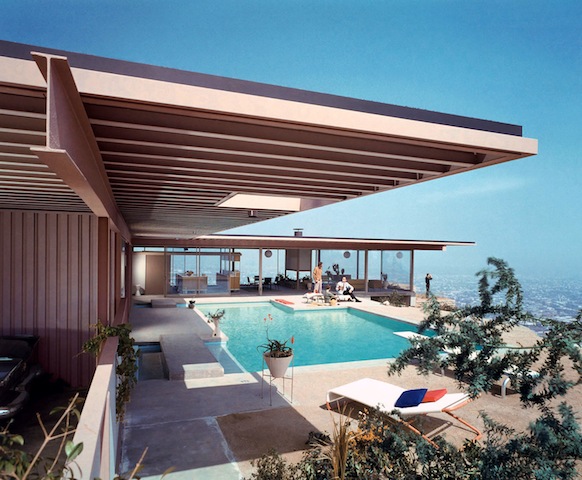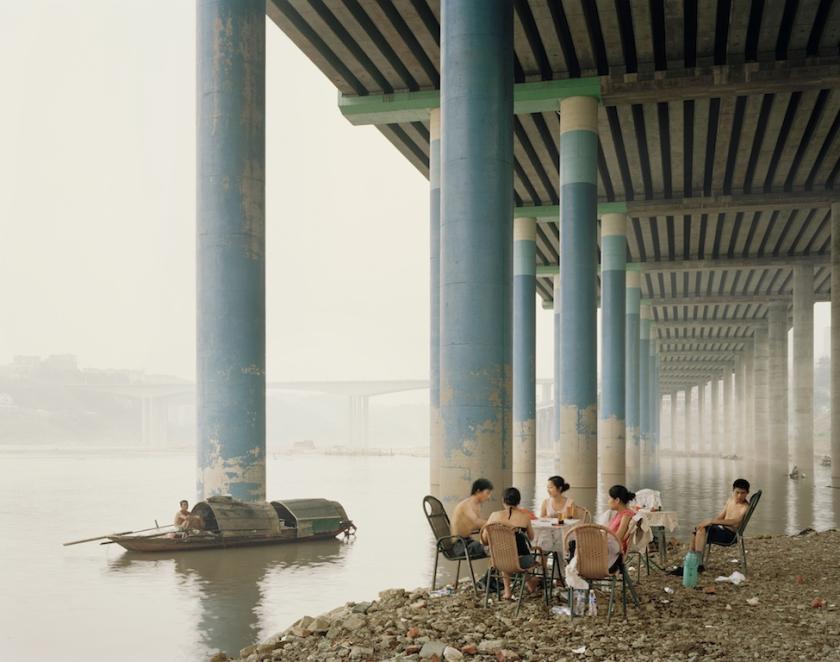“The minute I touched New York,” wrote Berenice Abbott, “I had a burning desire to photograph the city of incredible contrasts, the city of stone needles and skyscrapers, the city that is never the same but always changing.”
Backed by funding from the Federal Art Project, the elegiac photographs she took of New York in the 1930s record cluttered corner shops and brownstones standing cheek by jowl with new high rise developments. “The past jostling the present” was how she described the juxtapositions of old and new that she found so inspiring (pictured below left: Rockefeller Centre, New York City 1932). At the junction of West Houston and Mercer a row of makeshift squatters’ huts huddles against high walls; seen from a high vantage point, Seventh Avenue is like a glistening river of light flanked by darkness and Broadway is a pencil-thin canyon punctured by shafts of light infiltrating from the side streets.
 Abbott is the earliest of 18 photographers included in Constructing Worlds, a fascinating survey of the love/hate relationship that has prompted people to photograph buildings the world over. Using a large format Victorian camera, Japanese artist Hiroshi Sugimoto began in 1997 to document some of the iconic buildings of the 20th century. The soft focus of his silver gelatin prints lends a dreamy romanticism to Frank Lloyd Wright’s Guggenheim and Le Corbusier’s Chapelle Notre Dame du Haut at Ronchamp.
Abbott is the earliest of 18 photographers included in Constructing Worlds, a fascinating survey of the love/hate relationship that has prompted people to photograph buildings the world over. Using a large format Victorian camera, Japanese artist Hiroshi Sugimoto began in 1997 to document some of the iconic buildings of the 20th century. The soft focus of his silver gelatin prints lends a dreamy romanticism to Frank Lloyd Wright’s Guggenheim and Le Corbusier’s Chapelle Notre Dame du Haut at Ronchamp.
The gentle reverence with which Sugimoto approaches his subjects is in marked contrast to the scepticism that permeates so much of the exhibition. Taken in 2006-7, Nadav Kander’s colour photos of the Yangtze River have a similar grandeur, but the message is far more dyspeptic. Beneath the soaring arches of high bridges – self-evident symbols of progress, since improved transport links open the way for development – people continue to swim, fish or picnic much as they have done for centuries. The image chosen for the cover of Constructing Worlds (Prestel), the book that accompanies this splendid exhibition, seems to hold up two fingers to grandiose schemes. Built beside the Yangtze apparently in the middle of nowhere, as a "Monument to Progress and Prosperity”, Fengjie III is a honeycomb of mouldering concrete blocks perched atop a mangy plinth, like a disgruntled robot abandoned in the boondocks with burned-out batteries.
 Shot in 2011, Iwan Baan’s photos of Torre David (pictured right) document the fate of another would-be beacon of progress. Erected in downtown Caracas in the mid 1990s, just before Venezuela’s economic crash, the Centro Financiero Confinanzas was designed to house banks, offices, restaurants and luxury hotels. But this 45-storey, glass and steel symbol of success was left unfinished and, after standing empty for 12 years, was taken over by squatters who transformed the skeletal structure into a place that 3,000 people called home. They built make-shift walls, moved in furniture, put up curtains and pictures, opened shops, a gym, a barber’s shop and chapel. Baan’s pictures pay homage to the resourcefulness of these people, who were finally evicted earlier this summer.
Shot in 2011, Iwan Baan’s photos of Torre David (pictured right) document the fate of another would-be beacon of progress. Erected in downtown Caracas in the mid 1990s, just before Venezuela’s economic crash, the Centro Financiero Confinanzas was designed to house banks, offices, restaurants and luxury hotels. But this 45-storey, glass and steel symbol of success was left unfinished and, after standing empty for 12 years, was taken over by squatters who transformed the skeletal structure into a place that 3,000 people called home. They built make-shift walls, moved in furniture, put up curtains and pictures, opened shops, a gym, a barber’s shop and chapel. Baan’s pictures pay homage to the resourcefulness of these people, who were finally evicted earlier this summer.
The residents of Mokattam Ridge on the outskirts of Cairo make a living from recycling the refuse of the city. Photographing the jerry built blocks from above in 2009, Bas Princen captures a sea of flat roofs piled high with the detritus of urban living.
You have to go back to the 1950s to find a photographer who believed that modern architecture could actually deliver the good life. To encourage well-heeled Americans to employ modern architects to design their dream homes, in 1945 Arts and Architecture magazine launched an initiative to build 24 Case Study Houses designed by exponents of the international style, such as Craig Ellwood and Eero Saarinen. Visuals were provided by Julius Shulman, whose photographs were prepared as carefully as an advertising shot. The epitome of elegance and ease, his picture of Pierre Koenig’s Stahl residence has become a classic (pictured below). Three people relax by the pool while, standing on the cantilevered terrace, a fourth enjoys a spectacular view of Los Angeles which is spread out below like a carpet. The house appears to be hovering in the stratosphere very close to heaven.
 A similar degree of optimism inspired the modernist buildings that sprang up in the Sixties and Seventies in newly independent African countries such as Angola, the Congo and Mozambique. But throwing off the yoke of colonialism proved unexpectedly difficult; economies faltered and buildings erected to symbolise progress were left to crumble. The Grande Hotel in Beira, Mozambique, for instance, was designed to accommodate wealthy guests, but when they failed to materialise it was turned into an apartment block. Guy Tillim’s photographs of the decaying concrete terraces (pictured below in 2008) are a melancholy testament to frustrated hopes and unexpected setbacks.
A similar degree of optimism inspired the modernist buildings that sprang up in the Sixties and Seventies in newly independent African countries such as Angola, the Congo and Mozambique. But throwing off the yoke of colonialism proved unexpectedly difficult; economies faltered and buildings erected to symbolise progress were left to crumble. The Grande Hotel in Beira, Mozambique, for instance, was designed to accommodate wealthy guests, but when they failed to materialise it was turned into an apartment block. Guy Tillim’s photographs of the decaying concrete terraces (pictured below in 2008) are a melancholy testament to frustrated hopes and unexpected setbacks.
 The exhibition is not a catalogue of misguided optimism and failed ambition, though; it is more complex and more interesting than that. The myth propagated after “the war to end all wars” that utopia was just around the corner is gently probed and debunked. Life proved so much more challenging, and grubbier, than the post First World War visionaries anticipated; the clean lines and uncluttered spaces of the international style failed to solve inequality, hardship and social unrest. Nor was a single solution ever possible; as Berenice Abbott’s photographs of New York show, places have to constantly change in order to accommodate fresh needs and new desires. That’s what makes them and this exhibition so endlessly fascinating.
The exhibition is not a catalogue of misguided optimism and failed ambition, though; it is more complex and more interesting than that. The myth propagated after “the war to end all wars” that utopia was just around the corner is gently probed and debunked. Life proved so much more challenging, and grubbier, than the post First World War visionaries anticipated; the clean lines and uncluttered spaces of the international style failed to solve inequality, hardship and social unrest. Nor was a single solution ever possible; as Berenice Abbott’s photographs of New York show, places have to constantly change in order to accommodate fresh needs and new desires. That’s what makes them and this exhibition so endlessly fascinating.










![SEX MONEY RACE RELIGION [2016] by Gilbert and George. Installation shot of Gilbert & George 21ST CENTURY PICTURES Hayward Gallery](/sites/default/files/styles/thumbnail_125_x_125_/public/mastimages/Gilbert%20%26%20George_%2021ST%20CENTURY%20PICTURES.%20SEX%20MONEY%20RACE%20RELIGION%20%5B2016%5D.%20Photo_%20Mark%20Blower.%20Courtesy%20of%20the%20Gilbert%20%26%20George%20and%20the%20Hayward%20Gallery._0.jpg?itok=3oW-Y84i)




Add comment